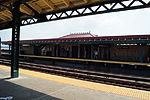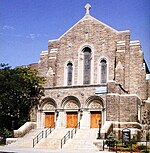St. Jude Church (New York City)
1949 establishments in New York City20th-century Roman Catholic church buildings in the United StatesBrutalist architecture in New York CityChristian organizations established in 1949Inwood, Manhattan ... and 6 more
Manhattan church stubsRoman Catholic churches completed in 1951Roman Catholic churches completed in 1954Roman Catholic churches completed in 1957Roman Catholic churches completed in 1975Roman Catholic churches in Manhattan

The Church of St. Jude, located at 3815 Tenth Avenue at the corner of West 205th Street in the Inwood neighborhood of Manhattan, New York City, is a Catholic parish church in the Archdiocese of New York. Established in 1949, the current sanctuary was built in 1975-76 and was designed by Clark & Warren in the Brutalist style. The School of St. Jude, located around the corner at 431 West 204th Street and built in 1949–51 to designs by Voorhees, Walker, Foley & Smith, was originally the sanctuary as well. A two-story rectory at 411-445 West 204th Street was built in 1957 to designs by architect P. Goodman.
Excerpt from the Wikipedia article St. Jude Church (New York City) (License: CC BY-SA 3.0, Authors, Images).St. Jude Church (New York City)
West 205th Street, New York Manhattan
Geographical coordinates (GPS) Address External links Nearby Places Show on map
Geographical coordinates (GPS)
| Latitude | Longitude |
|---|---|
| N 40.862905555556 ° | E -73.919744444444 ° |
Address
Saint Jude (Saint Jude's Roman Catholic Church)
West 205th Street
10034 New York, Manhattan
New York, United States
Open on Google Maps








